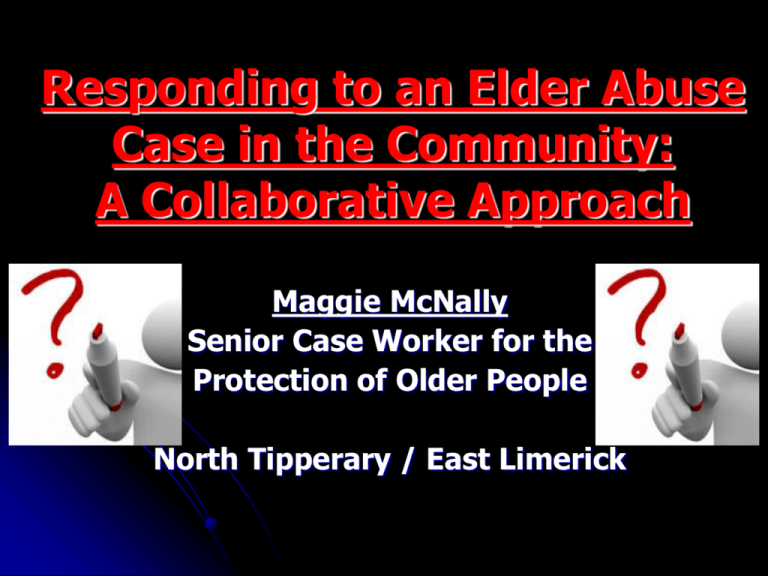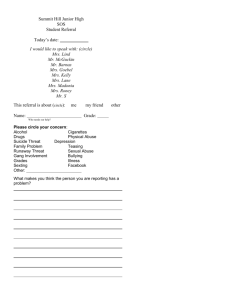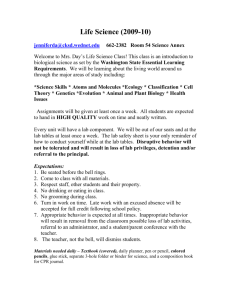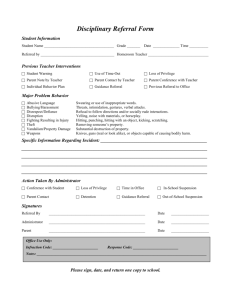MaggieMcNally_WEAAD - June 2013 (2)
advertisement

Responding to an Elder Abuse Case in the Community: A Collaborative Approach Maggie McNally Senior Case Worker for the Protection of Older People North Tipperary / East Limerick LIVE LONG….. BE HEALTHY….. Case Process Referral Assessment Intervention Referral 88 year old female - Mrs. T Visually impaired Subject to multiple fractures / falls Lives with 92 year old husband – Dementia No Children – niece lives locally and manages finances Private care – 1 person only Referral Continued… Recent fall, Hospital admission (surgery) Required Rehabilitative services prior to going home - Discharge Co-ordinator arranged a period of rehab in Nursing Home Opposition from niece Questions previously regarding falls by hospital staff; no referral made however given nieces demeanour/response a referral was forwarded by Discharge Co-ordinator to Service for Protection of Older People What next – Assessment Referrer- Background information / concerns Meeting with Mrs. T at Hospital Contact with G.P / PHN Meeting with Mr. T at Home Contact with niece Contact with private carer Ongoing contact with Mr. and Mrs. T. What next? Safety Assessment Risks identified Other professionals contacted – O.T, Home Help Service, Home Care Package, Alzheimer Society – Home Support/Day Care Centre, NCBI Case Conference Safety Assessment Is the older person in immediate danger? What steps can be taken to increase safety? Prevent social isolation Decrease Caregiver stress Manage medical issues Case Conference The purpose of a case conference is to bring together all the relevant people involved in the care/future care of the older person in order to: Exchange information Determine the degree of risk To formulate a plan to protect the service user To make arrangements for the monitoring and the review of the case Case Conference To clarify the roles and responsibilities of the various professionals involved To nominate a key worker To establish a care plan to work with the perpetrator if he/she is also a person who is vulnerable To arrange for any other appropriate follow up Professionals / Agencies Involved…. Discharge Coordinator – Hospital Registrar / Consultant – Hospital Nursing Home Rehabilitation Unit G.P PHN Alzheimer Society (Day Centre / Home Support) Social Worker – NCBI Professionals / Agencies Involved…. Occupational Therapist Physiotherapist Home Help Service /Home Care Package/ Private Care Counselling Service Social Welfare Department Senior Case Worker for Protection of Older People Intervention Ongoing Home Visits - monitoring Assessment concluded that home environment was safe Private care supplemented with Homehelp/Home Care Package/Alzheimer Soc. Counselling for Mrs. T Support from NCBI O.T aids for house / Mr. and Mrs. T Intervention cont’d Physio – Rehab Unit Social welfare – pension Rehab Unit – Discharge plan Day Centre – Alzheimer Society – Mr. T Meals on Wheels Pendant Alarm – Social Services Goal of reporting is to: Find a solution to the problem not to make situation worse Keep the Older Person at home Enlist resources Other Possible Interventions Referral to counselling (older person &/or abuser) Dietary assistance Housing assistance Mediation service Emergency responses for housing, food, health (crisis intervention) Placement in Long Term Care Key Points Multiple types of Elder Abuse typically occur – Polyvictimisation Complexities professionals confront Collaborative efforts are necessary in responding effectively to Elder Abuse cases




